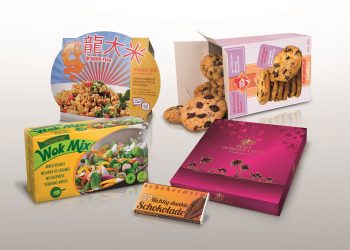Packaging has been limited to an outsourced activity for most brand owners. However, globalisation and digitalisation have given a new perspective on packaging safety to the entire packaging supply chain. Now consumers are more aware and hence emphasis laid by brand owners and authorities upon packaging safety has seen a steep positive drift over past few years. It has been well acknowledged by partners of the supply chain that packaging compliance can only be assured by following an integrated approach between converter, substrate manufacturers, ink manufacturers and others. Further implications of this integrated approach also mean careful selection of the partners in the supply chain considering their understanding of compliance and the systematic approach they deploy to ensure compliance consistently.
The Indian packaging industry has constantly been innovating, but the same hasn’t been the case for packaging inks. However, the scenario is changing in the market where innovations are made to produce migration optimised inks suitable for food packaging, pharmaceuticals and other consumer goods. It would mean a shift from toluene-based inks to toluene free inks and mineral oil-based inks to mineral oil free inks and much more.
Concept of Safe Packaging Inks :
Safe Packaging Inks are inks formulated with careful selection of raw materials in accordance with legal requirements of the region, brand owner requirements, and self-commitment from the ink manufacturers.
Ink manufacturers needs to be aware of the legal requirements (relevant for a particular region) for packaging inks and must build systematic processes to ensure delivery of consistent and safe products. If the packaging material needs to be exported, the legal requirements of the importing country must also be given due consideration. Ink manufacturers not only need to select the raw materials carefully but also keep themselves updated on changing legal and other requirements, as well as the reclassification of the used raw materials. In addition to that, ink manufacturers also need to validate the migrants for the worst-case calculation and shall share the results transparently with the downstream stakeholders for the risk assessment of the packaging material.
Brand owners, with their global footprints, sometimes have their own specific requirements for packaging safety beyond the legal requirements of the countries (especially developing countries like India). Each supply chain partner (including ink manufacturers) needs to make themselves aware of such requirements and upgrade their products to comply with such norms, in order to offer the same level of consumer safety across all regions.
An ink manufacturer is responsible for their own products and formulations. Hence, it becomes the ethical responsibility of supply chain partners to deliver safe products (with only safe chemicals in their formulations) and update the authorities and brand owners on such initiatives to benefit the society at large. Ink manufacturers needs to demonstrate self-commitment to packaging safety even if it means going beyond the legal obligations for the region.
Compliance can never be achieved through an isolated approach since each packaging structure is a mixture of different components (including substrate, ink and varnishes), and hence, a responsible ink manufacturer should openly and transparently communicate across the supply chain on the requirements, as well as on the risk assessment of the individual components of the packaging inks, whenever required.
Migration Optimized Inks (Safe Inks) :
The word “safe inks” is a commonly used abbreviation by the brand owners when they intend to ask for inks that will not allow the migration of contaminants which can possibly impact food safety aspects of their product. However, in absence of any standard definition for safe inks, different misnomers have been introduced and are now prevalent in the market, most common of which are Non-Toluene inks (NT inks) ,Non-Toluene Non-ketone Inks (NTNK inks ), mineral oil free inks, cobalt drier free inks etc.However, the most appropriate technology should be – “Migration Optimized Inks”
Ink at the constituent level can be seen as a mixture of even 60-80 chemicals, categorised into different categories (including binders, pigments, additives and solvents) with specific technical functions. Ink manufacturers manufacture migration optimized inks by selecting the raw materials carefully across all the categories – binders,pigments, additives, solvents. The careful selection by an ink manufacturer needs to meet the legal requirements, brand owner requirements as well as self-commitments and should also consider the latest classification status for the chemicals used in formulating inks. In addition to that, ink manufacturers also need to validate the migrants for the worst-case calculation and shall share the results transparently with the downstream stakeholders for the risk assessment of the packaging material.
Migration Optimized Inks vs Misleading Terminologies (NTNK Inks / Mineral oil free Inks ) :
To understand this, let us assume you procure NTNK inks or Mineral oil free inks from a supplier. In such a case you only have the assurance that the ink doesn’t contain toluene and ketone as the solvents or Mineral oils as solvent respectively. However, this doesn’t give you any assurance that the ink doesn’t contain other solvents like benzene, Monochlorobenzene(regulated under IS 15495) , heavy metals , formaldehyde ( regulated by few brand owners) , CMR (carcinogenic, mutagenic , toxic to reproduction) category chemicals (regulated by self-commitment from ink manufacturer) . In totality, NTNK inks / Mineral oil free inks do not give you an assurance that the inks are compliant to legal requirements, to brand owner requirements as well as self-commitments from a responsible ink manufacturer.
This means use of such ink (with misleading terminologies) can have following results:
- Possible failure against legal requirements (domestic as well as export)
- Possible failure against the brand owner requirements
- Possible failure against the self-commitments from an ink manufacturer
And eventually all of the above will lead to following consequences:
- Damaged brand reputation
- Financial losses
- Product recall / scandals
- Media trials
- Regulatory authority trials
- Sales loss
- And in extreme cases, entire business loss.
Migration optimised inks – the right way ahead
Migration optimised inks is the future for safe packaging as these are the inks where all raw materials have been carefully selected to minimise the potential for the transfer of contaminants from inks into the food. These inks go far beyond the legal requirements and ensure full compliance with the EUPIA guidelines amongst the EUPIA GMP. These packaging inks are formulated and manufactured taking into consideration many individual and varying parameters relating to substrate, application and end use.
Having said that, it has to be acknowledged that migration optimised inks need to be supplemented with the good manufacturing practices at the converter shop floor and validation of the final printed article, to ensure safe packaging for food products. Needless to say, getting migration optimized inks from a responsible ink supplier and following an integrated approach across the packaging supply chain is most critical for implementing safe packaging.
Head - Product Safety and Regulatory, Siegwerk India
Jatin Takkar is a Food technologist specializing in Food safety. He holds a Master’s degree in Food Technology from Guru Nanak Dev University, Amritsar. He has worked in areas of Operations, Quality, Food safety as well as Regulatory with companies like Nestle, Kraft Heinz. He has held his current role at Siegwerk India for 3 years as Head – Product safety and Regulatory, responsible for product safety and regulatory compliances of packaging inks. He is also a certified auditor for ISO 22000, Food Safety and Management Systems. With his expertise in food safety, and his focus on packaging safety he is now supporting the packaging supply chain in understanding and implementation of food safety from the perspective of Packaging inks. His motto – “Ensuring Safe food for everyone”.






